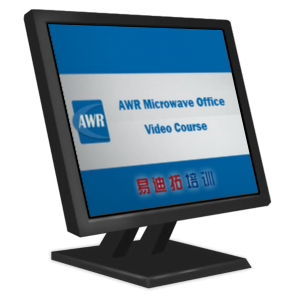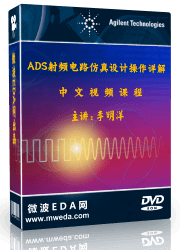
Learning RF Design using Microwave Office
英文视频培训教程
射频理论讲解和Microwave Office使用相结合,在射频基础学习中, 更好掌握Microwave Office使用...
- 个人专业版
- U盾版
- 企业版
- 价格
- 299元
- 499元
- 699元
这是一门非常棒的Microwave office学习培训课程,课程把微波射频基础知识的讲解和Microwave Office使用紧密结合起来,借助于Microwave Office软件把抽象的微波射频知识可视化、直观化,让学员可以更好的理解和掌握。而且,在学习、理解射频知识的同时,也能学会和掌握Microwave Office软件的仿真设计应用。可谓一举两得,相得益彰,是不可多得的射频工程师入门课程和Microwave Office使用培训教程。课程全长12个半小时,英文讲解,共35节课,具体内容如下:
1. Introduction to AWR Microwave Office
2. RF circuits anlysis using Microwave Office
2.1 TDR——Time Domain Reflectometry (part 1)
2.2 3D EM animation(No Audio)
2.3 DC Simulation
2.4 AC Simulation
2.5 Coaxial Cable Simulation using MWO
2.6 Microstrip Designing and Simulation using MWO
3. RF Fundamentals learning using Microwave Office
3.1 Reflection coefficient analyzing using MWO
3.2 the concept of Reflection coefficient and VSWR and how simulate them using MWO
3.3 Slotted line using MWO
3.4 TDR-Time domain reflectometry (part 2)
4. Impedance matching circuits design with Microwave Office
4.1 Resistors, capacitors and inductors at RF Circuits
4.2 L-section matching.
4.3 L-section matching using measurement ports
4.4 Analysing series RLC circuits using Impedance Smith Chart
4.5 Analysis of parallel RLC using Admittance Smith Chart
4.6 Impedance Matching with series capacitors and series inductors
4.7 Impedance Matching with shunt capacitors and shunt inductors
4.8 Impedance matching on Smith chart with series and parallel elements( RL>RS)
4.9 Impedance matching on Smith chart with series and parallel elements ( RL
4.10 Comparison of different topologies of matching networks including return loss (S11) vs frequency and insertion loss (S21) vs frequency. 3dB-bandwidth and Q
4.11 Designing matching networks with specific Q. Comparison of frequency response of T and L-matching networks
4.12 Designing matching networks with specific Q. Three-element matching, Pi-networks. Design of pi-matching and L-matching network with iMatch in MWO
4.13 Matching any two complex terminations on the smith chart
4.14 Transmission line matching with open and short circuited transmission line stubs
5. Amplifier Design using Microwave Office
5.1 BJT Amplifier Design Part 1. I-V characterisation of BJTs.
5.2 BJT Amplifier Design Part 2. RF chokes, how to select their value.
5.3 Amplifier Stability Part 1. Gain Variation versus frequency
5.4 Amplifier Stability Part 2. Stabilisation though reactive emitter degeneration
5.5 Unilateral Match-Design input and output matching networks for amplifiers
5.6 Simultaneous Conjugate Match Part 1. Achieving maximum small-signal gain using GM1 and GM2, Design of distributed matching networks
5.7 Simultaneous Conjugate Match Part 2. Broadband gain profile
5.8 Operating Gain Circles Part 1. Writing 2-port S-parameter files (.s2p) and using them for amplifier design
5.9 Operating Gain Circles Part 2. Amplifier design for a specific gain with an unstable device
5.10 Available Gain Circles. Amplifier design for a specific gain with an unstable device using available gain circles (GACIR)
注:在线试看片段作了压缩处理,课程的实际效果比此处的在线演示片断更加清晰。您也可以下载该视频试看片段到本机播放【点击下载高清片段】。
 ADS是美国Agilent公司研发的微波射频电路、通信系统和MMIC/RFIC仿真设计软件,其功能强大、应用广泛,被国内高校、科研院所和大型IT公司广泛使用。掌握ADS,对于射频工程师来说无异于如虎添翼,可以有效提升自己的技术实力、提高工作效率。高级套装中包含易迪拓培训全10门ADS培训课程和教材,帮助学员全面深入学习掌握ADS的设计应用。【详细...】
ADS是美国Agilent公司研发的微波射频电路、通信系统和MMIC/RFIC仿真设计软件,其功能强大、应用广泛,被国内高校、科研院所和大型IT公司广泛使用。掌握ADS,对于射频工程师来说无异于如虎添翼,可以有效提升自己的技术实力、提高工作效率。高级套装中包含易迪拓培训全10门ADS培训课程和教材,帮助学员全面深入学习掌握ADS的设计应用。【详细...】 最新版ADS的入门和进阶培训课程,适合ADS2011 ~ ADS2014 版本ADS的学习。李明洋主讲,高清视频,直观易学。课程从基础讲起,通过设计实例,边操作边讲解,全面讲授了ADS在射频电路的仿真设计、微波平面电路的电磁仿真分析和RFIC设计的工程应用。通过该门课程的学习,可以帮助你快速上手掌握ADS的使用,并实现把ADS应用实际工作中去【详细...】
最新版ADS的入门和进阶培训课程,适合ADS2011 ~ ADS2014 版本ADS的学习。李明洋主讲,高清视频,直观易学。课程从基础讲起,通过设计实例,边操作边讲解,全面讲授了ADS在射频电路的仿真设计、微波平面电路的电磁仿真分析和RFIC设计的工程应用。通过该门课程的学习,可以帮助你快速上手掌握ADS的使用,并实现把ADS应用实际工作中去【详细...】 本课程基于新版的ADS软件,由李明洋老师讲授,讲解了ADS在微波射频模拟电路设计中的具体应用。课程为全程高清视频,边操作边讲解,直观易学,能够帮助你在最短的时间内学习掌握ADS的使用操作;课程同时结合工程设计实例来讲解,能够让你在学完之后,迅速地把ADS应用到微波射频电路的研发工作中去,真正学有所用,提升你的技术水平和工作效率【详细...】
本课程基于新版的ADS软件,由李明洋老师讲授,讲解了ADS在微波射频模拟电路设计中的具体应用。课程为全程高清视频,边操作边讲解,直观易学,能够帮助你在最短的时间内学习掌握ADS的使用操作;课程同时结合工程设计实例来讲解,能够让你在学完之后,迅速地把ADS应用到微波射频电路的研发工作中去,真正学有所用,提升你的技术水平和工作效率【详细...】 该门课程旨在帮助学员快速、全面、透彻地理解高低阻抗线微带滤波器的设计原理和设计步骤,帮助学员学会并掌握使用ADS软件仿真分析和优化设计微带线滤波器的实际操作,包括微带线滤波器的原理图电路的分析和优化、Layout版图结构的分析和设计优化,以及如何使用ADS DesignGuide来快速设计高低阻抗线微带滤波器【详细...】
该门课程旨在帮助学员快速、全面、透彻地理解高低阻抗线微带滤波器的设计原理和设计步骤,帮助学员学会并掌握使用ADS软件仿真分析和优化设计微带线滤波器的实际操作,包括微带线滤波器的原理图电路的分析和优化、Layout版图结构的分析和设计优化,以及如何使用ADS DesignGuide来快速设计高低阻抗线微带滤波器【详细...】
